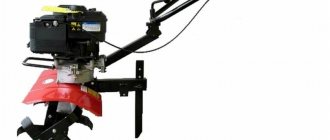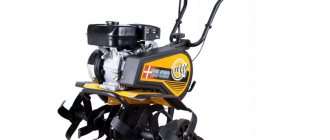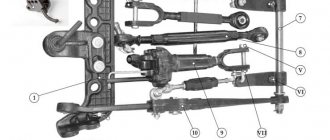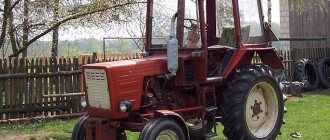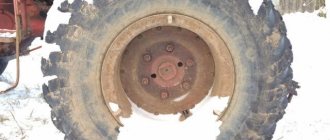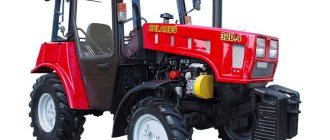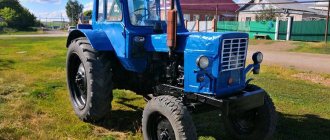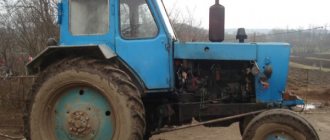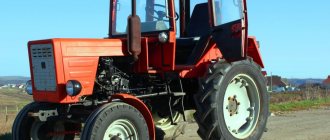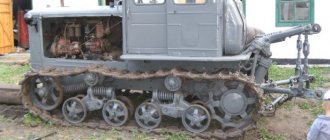Stubble cultivator - this device is used to cultivate the stubble that remains after harvesting. Also, stubble cultivators are often used for soil cultivation before sowing and fallow care. Cultivation includes several actions: covering stubble, leveling the surface for sowing, cutting weeds. Plant residues help fertilize, retain moisture and loosen the soil. A stubble cultivator can easily replace standard plowing of fields in winter. The position of the tines, discs and rollers can be adjusted. The rollers have a special structure - without a central axis, so they do not become clogged with plant debris.
Purpose of the cultivator
The cultivator at MTZ is widely used for cultivating various types of soil. One of the characteristic features that has made this type of equipment incredibly popular is a large set of functions, as well as a simple and reliable design that guarantees a long service life.
Cultivators installed on tractor equipment from this manufacturer are considered to be universal agricultural tools that can be used to carry out various types of work. Among them, worthy of mention:
- loosening the top layers of soil;
- hilling of tubers;
- weed elimination;
- processing the space between rows;
- adding various fertilizers to the soil.
The cultivator can be used as a separate tool or as part of complex solutions that also include a harrow, milling cutter and other types of equipment.
Cultivators simplify the process of plowing the land
Device
The demand for various cultivators among farmers is due to their simple design, which is worth studying in more detail. The basis of cultivators at MTZ is a frame made of a metal profile. The design may include 1 or several frames, which are equipped with working elements.
The operating principle of this type of product is extremely simple:
- The device is attached to the tractor.
- When the tractor moves, the working mechanisms of the device are activated.
- With the help of installed working knives, the cultivator loosens the soil, gets rid of weeds or performs another type of processing.
In this case, the cultivator can be mounted on the MTZ using both the front and rear linkages, as well as using a hitch. Engine energy is transmitted via the power take-off shaft. Working knives are made of high-strength steel, which is resistant to wear, corrosion, and mechanical stress.
Be sure to read: Motoblock Texas (Texas): characteristics, reviews
Depending on the modification, some models of cultivators can be equipped with support elements, with the help of which the depth of cultivation can be adjusted. Models available for sale are equipped with a hydraulic drive, which is used to move the device into a vertical state.
Disc harrow for MTZ 82: how it works and why it is needed
Today, quite a lot of people living in rural areas own a certain plot of land. In order to have a decent harvest from it, it is necessary to properly care for the soil.
For these purposes, a person needs special equipment. For example, a device such as a disc harrow is very actively used to treat the soil before planting. Let us dwell in more detail on its design and application.
What it looks like and how to choose the right mounted mineral fertilizer spreader is indicated in this article.
A disc harrow is an agricultural unit that can become a worthy replacement for a cultivator, plow, or hoe. Thanks to this attachment, it becomes possible to cultivate land with a moisture level of no more than 25%.
This type of suspended structure consists of a specific number of disks. Relative to the vertical main axis of the structure, it is concentrated at an angle. This is what allows you to adjust the depth in the ground and determine the processing angle.
In the video - a disc harrow for MTZ 82:
According to the design of the working part, this device can be made into two types: hinged and mesh. When cultivating land where there are many roots from previous plants, it is extremely profitable to buy a disc harrow designed for stone soil.
You can learn about how the Polesie combine harvester is used from this article.
The mesh design is an old model, but has already been tested by time. The base of the product is made of metal mesh, onto which teeth are attached in various ways. The installation of teeth can be different depending on the intended purpose. The teeth can be presented in a curved form, straight or as a spring element.
For a more correct distribution of fertilizer and loosening the soil with vegetation residues, it is necessary to use a harrow with discs, which can increase the resistance of the soil surface to various types of erosion processes. It is also necessary to increase its absorption capacity.
Also, the presented devices working in tandem with the MTZ 82 tractor can be divided according to their intended use.
Types of cultivators
Before you find out how much the price of a cultivator is, you need to familiarize yourself with the classification of this kind of product. It stipulates that equipment is divided according to the type of working elements, operating principle, installation method and specialization.
The most important parameter seems to be the type of installed working elements, since the efficiency, as well as other indicators of the cultivator, directly depends on it. The most commonly used elements are:
- disks. They are distinguished by their affordable cost, due to the ability to cut soil into layers, they are widely used in hot climates with low rainfall;
- pointed elements. A universal solution that demonstrates the highest efficiency in removing weeds. Ideal for processing loamy, silty soils;
- stubble devices. High efficiency in removing weeds, as well as loosening the soil, which is especially important when preparing for sowing;
- plowshares. They are small plow-shaped elements that are used for gentle cultivation of large areas;
- cutters. Suitable for soil preparation before operating a cassette harvester. It has an impressive processing depth, which can reach 35 cm;
- chisel. It is used relatively rarely, it is used for pulling the soil using plowshares, which helps improve aeration and also simplifies the application of various types of fertilizers;
- forest. It is used when it is necessary to reclaim the soil after successful cutting down of trees. Operation is possible only with the MTZ 80 model.
Cultivator model KPS-4
Most of these devices can be used in conjunction with all popular models of equipment from the Minsk Tractor Plant, which makes it easy to select a suitable solution taking into account the specifics of operation.
Cultivators for inter-row and continuous tillage using MTZ equipment
Cultivators are a type of agricultural equipment designed for loosening the surface layers of soil without turning over layers, hilling, destroying weeds, and also for applying fertilizers.
Cultivation units are used for the care of fallows (stubble cultivators), inter-row soil cultivation with the destruction of weeds, loosening and hilling of fertile soil, pre-sowing preparation of land, as well as for the reclamation of areas after deforestation.
Cultivator units are used both as independent agricultural implements and in mechanized complexes, which include other soil-cultivating devices - harrows, rollers, etc.
Review of popular models
Before you learn how to assemble a homemade cultivator for the MTZ tractor, it is advisable to study the most popular models of this type of equipment on sale. These include the following modifications:
- KPS-4 is a high-performance model, can be mounted or trailed;
- KPS-5U - used for continuous tillage, harrowing, as well as pre-sowing work;
- Bomet is a cultivator from a Polish manufacturer, suitable for loosening, mixing the soil, and eliminating weeds;
- Unia is a Polish model, adapted to domestic climatic conditions, used for plowing land, and has a 6-meter working width.
Be sure to read: Caterpillars for walk-behind tractors
There are many other models of equipment that are popular among Russian farmers, for example, Vepr, which greatly simplifies the selection of the appropriate model.
Classification
If we classify such equipment according to the type of clutch, continuous tillage cultivators can be:
Cultivators of this type are used on allotments of any size and type of soil. At the same time, the upper surface is disked, crushed and buried, then the soil is leveled and compacted.
The immersion depth can be adjusted; the main task of such units is to destroy weeds before sowing, so the cutters do not dive deep. Trailed cultivators are easy to use and maintain. The levers are switched quickly by the operator; during operation, the equipment is easily leveled longitudinally and transversely. Thanks to the presence of a rigid hitch, the attachment is lifted along with the control system. The working parts are practically not clogged with plant debris. Mounted cultivators are used when incomplete crushing of solid soil fragments is necessary. After treatment with them, moisture remains in the ground for a long time.
DIY making
If desired, a farmer can make this type of device with his own hands, which will allow him to significantly save on purchasing factory-made analogues. It should be taken into account that the effectiveness of a homemade unit largely depends on its design, as well as materials of manufacture. The easiest option to manufacture is a disc cultivator, the assembly of which needs to be studied in more detail.
Required tools and materials
First of all, you need to make sure that you have all the necessary materials and tools that will be used in the manufacturing process. The master will need a standard set of tools, a welding machine, as well as the following elements:
- metal pipe with a cross section of 5 cm;
- square frame made of U100 channel;
- 2 wheels;
- 5 disks that will be used as the main working elements;
- rubberized belt.
It is also necessary to acquire a drawing and, if necessary, make changes to it in accordance with the preferences of the master, as well as the characteristics of the available materials.
Assembly order
The assembly order directly depends on the selected cultivator model that you plan to assemble. First of all, you should assemble the frame of the unit using a channel, as well as metal pipes in accordance with the drawing. Next, it is advisable to adhere to the following algorithm of actions:
- Mark where the work items will be placed.
- Assemble stands that can be adjustable or rigid.
- Install the working elements and wheels onto the finished frame.
- Make a coupling device of the required type in accordance with the characteristics of the tractor model used.
Be sure to read: Adapter for the Neva walk-behind tractor: drawings of a homemade device
Using a similar principle, you can independently make a lancet-type cultivator, which is due to a similar design.
Development of walk-behind tractors
Work on the creation of the first walk-behind tractor model began at the Minsk enterprise in 1978. The designers were tasked with making a single-axle machine capable of performing agricultural work in the field. At that time, farms needed to replace heavy physical labor and horsepower with self-propelled gasoline vehicles.
The mini tractor model produced at the enterprise was taken as a basis, and the development was given the index “Belarus” MTZ-05. The device cultivated the ground with milling cutters, which were installed on the drive axis, or with mounted tools.
Serial production of walk-behind tractors was established at the production sites of one of the MTZ branches - the aggregate plant (SAZ), commissioned in 1986. The first models were designated with the prefix “Belarus”, but later, after modernization of production, the index was changed to “Belarus”.
Owner reviews
Numerous online reviews confirm the quality of the mechanisms and the performance of the engines.
Alexei:
In my opinion, MTZ remains the most reliable walk-behind tractor in the post-Soviet space. My godfather's unit, produced in 1985, with its original engine still works. I bought myself one with a Honda engine. I’m happy that I didn’t make a mistake with my choice, as it works great and starts right away. Even in winter there are no problems with starting. To save money I use 92 gasoline. I don't see any downsides.
Which walk-behind tractor should you choose – MTZ or Chinese?
Chinese products have become so firmly established in our everyday life that they have become distinguished by their quality. You can often hear the phrase “this is quality China.” This applies to the Lifan engines they produce, which are produced using advanced technologies.
Chinese diesel models are an alternative to gasoline ones and allow you to significantly save on fuel, which itself is cheaper. In addition, the consumption of a diesel device is significantly less, which is an undeniable advantage than that of a gasoline device. But at the same time, the cost of such models is much higher, which does not make them popular on the market.
Prices
You can buy an MTZ device only through representatives or in online retail stores. All of them supply equipment directly from the plant’s warehouses. Prices of new walk-behind tractors:
- MTZ-06 MKR - 65-75 thousand rubles;
- MTZ-09N: Honda - 70-85 thousand rubles, Veima - 65-75 thousand rubles;
- MTZ-12 - 75-90 thousand rubles.
Discontinued models are purchased second-hand on the secondary market. Price of used walk-behind tractors:
- MTZ-05 - 30-47 thousand rubles;
- MTZ-06 - up to 60 thousand rubles. (with additional equipment);
- MTZ-08 (Briggs & Stratton engine) - 45-55 thousand rubles.
